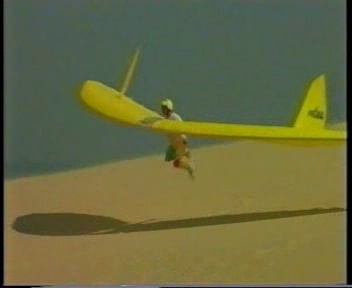

 Laurent holding the bow wing |
 Laurent
jumping on the dune
|
 Didier running to take off |
 Didier flying on the dune |


| Model |
Longbow |
Delka |
| Area (m2) |
13,7 |
|
| Span (m) |
10,5 |
|
| Weight (kg) |
25 kg (including harness) |
|
| Folded length (m) |
2,4 |
2,5 |
| Glide |
9:1 |
|
| Bow radius (m) |
14,8? |
7,88? |
| Profile |
reflex |
reflex (80% of span) |
| Bow preload (kg) |
180 ? |
|
| Frame |
HT30TF aluminum (6082-T6). Five sections 2 5/8", 2 1/2", 60 mm x 1mm wall |
Five sections, and two fiber glass tips |
| Year |
1992 |
1994 |
| Pitch load test |
+400 kg/ -150 kg |
|
| Observations |
Spiral dive tendency |




The rigid wing in an arc Structure is very curious...
We can imagine a continuous evolution from a wing with a simple beam structure, to a wing arc as follows:
1) One wing of simple beam, consists of a beam straight and guidelines section on "I", square circular, since virtually only must resist bending moments on a vertical plane (in the opposite direction to gravity). The axis of the beam would be coincident with the center of pressure profiles that make up the entire wing.
2) A simple evolution would be double the previous beam at its center. Bending the beam at an internal angle of 140 º and changing the section of the same to a "D" section gives the structure Millennium / Atos...
3) The choice of the Longbow / Delka to form the wing is to bend the beam in an arc. The advantage is a one-dimensional structure (a line formed by tubes spliced) easy to disassemble keep, and transport, which can be converted by bending in a two-dimensional structure (the plane's wing). The disadvantage is that the section of the main beam worked under tension (especially in the central section corresponding to the nose). It is therefore very important to select the proper way for the section of the main beam, their variation along the wingspan, and his material.
Brooks and Kalbermatten's solutions used simple circular aluminum tubes linked together, but can still be much development in this field... There's a lot of structural research to be done, but it is conventional problems ..., then come the aerodynamics research, profiles, and control mechanisms (tip rudders? or elevons + V tail?)...
Notes-5:
